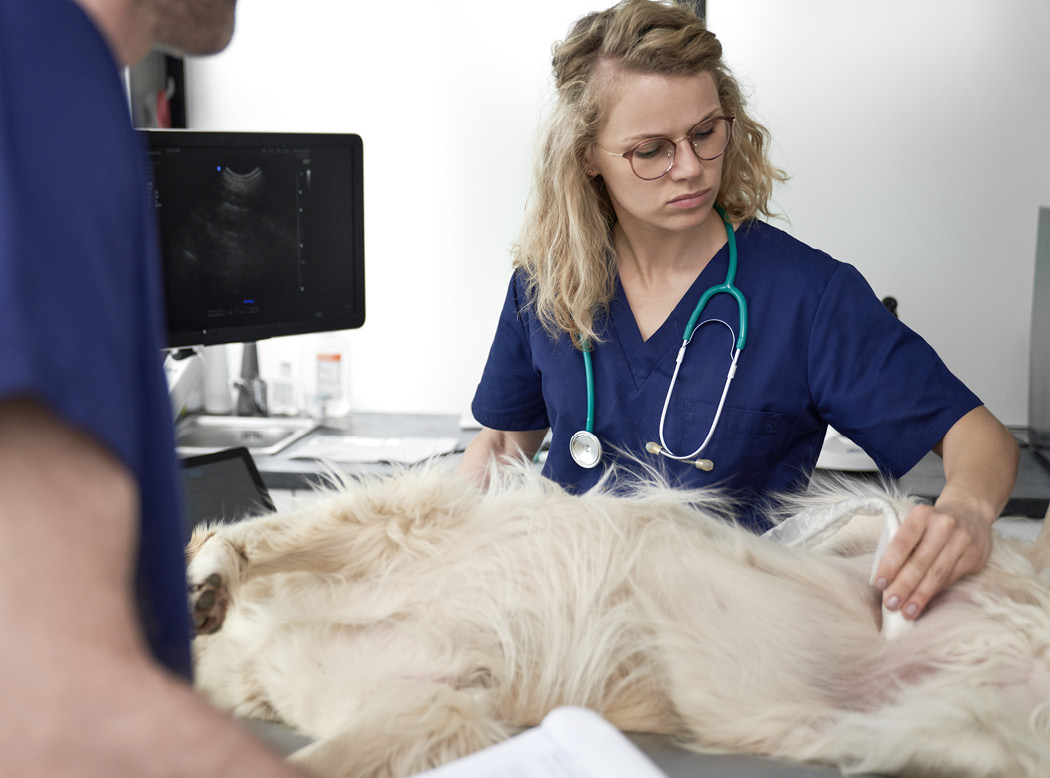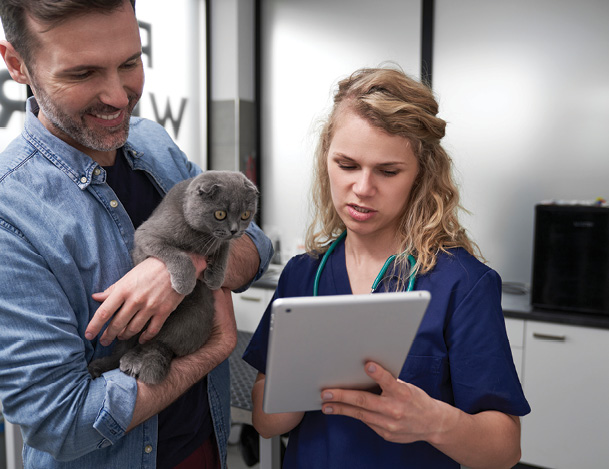Are Your Credentialed Technicians Allowed to Be All They Can Be?
Ease Doctor Shortage Woes by Making Full Use of Credentialed Techs
by Maureen Blaney Flietner

The shortage of veterinarians and team members and increased demand for patient care are unlikely to change for years. Could the stress be eased if veterinary hospitals fully utilized their credentialed technicians?
Several people we spoke with have discovered that it can.
Shlomo Freiman, DVM, CVO, co-founder of Petriage, a veterinary telehealth platform, and the former owner of Animal Hospital of Factoria, Bellevue, Washington, said he uses the analogy of a classical orchestra to explain the situation at some hospitals.
“Veterinarians think of themselves as being the first violinist instead of the conductor as they should. By always having to put the catheter in, draw the blood, interact with the client, the veterinarian becomes a bottleneck and burns out, too,” he explained.
“It comes down to veterinarians needing to ask themselves if they are being doctors—diagnosing and treating disease—or if they are performing tasks that trained professionals should be doing,” said Philip Richmond, DVM, CAPP, CPHSA, chief medical and wellbeing officer of Veterinary United, a practice consolidator headquartered in New Baltimore, Michigan.
“Efficient use of credentialed veterinary technicians can and will support the shortage of veterinarians,” said Shannon T. Thompson, RVT, former CEO/executive director, Registered Veterinary Technologists and Technicians of Canada. “Fully delegating tasks within your regulatory framework allows for DVMs to practice at the top of their license, allowing for credentialed vet techs to perform at theirs with the support of the entire veterinary team.”
How to Change the Situation
Proper team utilization is nothing new for Rebecca Rose, CVT, outreach specialist with Lap of Love Veterinary Hospice. She first spoke about it at a 2001 veterinary conference in Ohio.
Rose suggested that hospitals first get an education about nomenclature, title protection, and formally trained veterinary professionals. Next, review the practice acts and technician education manuals to determine the full scope of practice for technicians. Then, “turn ‘em loose,” she said.
However, as hospitals look to make changes, it’s important that they don’t confuse “busy” with “well-utilized,” emphasized Kenichiro Yagi, MS, RVT, VTS (ECC) (SAIM), chief veterinary nursing officer at Veterinary Emergency Group.
“Veterinary technicians can be running around frantically trying to get work done and being overworked because they are expected and tasked to do everything. Instead, develop a process in which the procedures and tasks are delegated to the appropriately skilled individual so that everyone can focus on the work that is best tailored to their level of expertise. This is a key to efficient workflow and team.”

Why Hospitals Should Make the Effort
Fully utilizing credentialed veterinary technicians is best “for patient care, client service, job satisfaction, technician retention, and hospital profitability,” said Rose. “It’s a wonderful cycle, and you keep credentialed team members on your team longer.”
That’s vital because credentialed veterinary technicians are leaving the profession at an alarming rate with one reason being the lack of proper utilization, according to the Veterinary Nurse Initiative website (veterinarynurse.org). Hospitals that turn that situation around should also expect to see increased job satisfaction from veterinarians because they will only be doing the things for which a DVM is needed.
“Our emphasis on empowering our technicians provides our customers with technician appointments for vaccines and defined rechecks. Our virtual care teams heavily rely on technician-driven appointments to gather diagnostic information and work with our virtual doctors to manage cases,” explained Audrey Wystrach, DVM, founder/CEO of Petfolk, which offers pet care through a mobile app, telemedicine, and pet care centers.
“People feel more valued and appreciated” when skills are used to their full extent, said Freiman. “And you can pay them more, too, because you are opening that bottleneck in the clinic. It’s not that it is all about money, but we all want to get paid so we can buy more equipment, nice toys, and all that.”
What Results to Expect
Advice may be great, but the proof of the pudding is in the eating. Our experts revealed how fully utilizing credentialed technicians and other team members has made a difference for them.
Financial gain is one result that should not be a surprise. Back in 2008, the American Veterinary Medical Association Biennial Economic Survey revealed a positive relationship between the number of credentialed technicians employed and gross practice revenue. The reasons were and still are apparent: those with greater skillsets could perform those tasks that veterinarians often take on even though they do not require a DVM level of expertise, and veterinarians then are free to handle the work that requires their training.
A 2018 study by the Ontario Association of Veterinary Technicians backs that up. It determined that “there was a strong positive association between annual gross revenue per veterinarian and the number of registered veterinary technicians per veterinarian.”
Each extra RVT per veterinarian increased gross revenues per veterinarian by more than $78,000, an economic effect seen only for RVTs and not their noncredentialed counterparts, the study found. In addition, the more RVTs are paid per hour, the higher the clinic gross annual revenue per veterinarian.
Pam Nichols, DVM, a past president of AAHA, reported that her “doctors each produce a million or a bit more in gross annual production working three to four days a week, getting out by 5:30 pm and taking a lunch. The only way that happens is by the doctors maximizing their whole team and especially the technicians. When we ensure that everyone is working at their highest and best use, production reflects it, but most importantly, morale and job satisfaction are high.”
Better efficiencies are another result. By fully utilizing credentialed staff and other team members, Petfolk has optimized appointments, improved the education of pet parents, enhanced customer experiences with a Net Promoter Score (NPS) above 90, maximized utilization of skills and knowledge, and enhanced job satisfaction, according to Wystrach.
Yet another benefit is wellbeing and all that entails, such as a sense of purpose and a feeling of pride of accomplishment. Richmond noted that a hospital wellness check in January 2022 found his entire medical staff scoring high in wellbeing and low in burnout. Those are scores he is more likely to find in practices he consults for that have a similar three-to-one or higher technician-to-doctor ratio.
Rose offered two examples for veterinary technicians:
“One technician working in a mixed animal practice enjoyed laboratory duties, was terrific with maintenance of the machines, excelled at follow-through, and communicated well with client education and relaying treatment plans. Together we designed her job description to be the ‘lab technician,’ tracking patient lab results, client follow-up, prescriptions related to treatment plan, and proper charges (missed charges!). She was given a plan for success, evaluation/review, and raise because of her increased responsibilities.
“The other credentialed veterinary technician worked within a mobile practice supporting veterinarians delivering pet hospice care. In a similar fashion, a job description was created to fully outline the duties and tasks. She worked directly with her manager and veterinarian to create standard operating procedures for the new role and has been supported in the transition. Her team is reaping the benefits of improved client communications, patient care, and veterinary efficiency because of her rise in becoming a hospice care technician.”
How to Avoid Pitfalls
Both veterinarians and credentialed veterinary technicians need to become educated about the skills, knowledge, and professional liability for the specific tasks that regulations delegate to them so that each can work to the top of their license, explained Thompson.
Unfortunately, being unaware of that information can lead some veterinarians to fear losing or possible litigation of their license. A lack of understanding also means tasks may be inefficiently delegated, which can create inefficiencies and underutilization of team members, she said.
Although credentialed veterinary technicians have the foundational knowledge of the science, physiology, and nursing concepts through their education so they can become proficient faster and at more advanced levels, noted Yagi, there also are many noncredentialed individuals who are motivated and learned to be proficient.
Yagi suggested that hospitals “celebrate both types of team members for who they are. Credentialed veterinary technicians have dedicated time, effort, and finances to educating themselves to prepare for their careers. They know the ‘why’ behind the ‘how’ and deserve the recognition. There are also noncredentialed individuals with varied levels of experience. Some of these people will eventually become credentialed. Some of these individuals have been in the field for decades and have helped build the profession. The veterinary team is made up of people of different backgrounds, and we should celebrate them all.”

“The veterinary team is made up of people of different backgrounds, and we should celebrate them all.
—Kenichiro Yagi, MS, RVT, VTS (ECC) (SAIM), chief veterinary nursing officer at Veterinary Emergency Group.
What About the Future?
Wystrach said technicians have the opportunity to play a central role in transforming the veterinary care system. “If our industry is to capitalize on this opportunity,” she cautioned, “the constraints of outdated policies, regulations, and legacy barriers, including those related to the scope of practice, will have to be lifted.”
Richmond noted that it was only through talking to a friend who is a certified veterinary technician specialist in anesthesia that he became aware of all of the advanced care those specialists could handle.
“When she told me the tasks she was able to do, it brought up a discussion about whether technical specialists might be able to fill a potential role in veterinary medicine in a task-oriented way. They could do many of the things that veterinarians in general practice settings could do.”
For Freiman, it’s not just a workflow change but a cultural change that is needed. “Doctors and leadership have to buy in, have to let go. That’s the hardest part. They have to supervise, to be the conductor. You can’t let everyone play their instrument every which way they want. Support staff also needs to buy into the idea. We need to make decisions together, to train them, and be there for them.”
With all of the good that might come, what might be behind any reluctance in hiring and fully using credentialed veterinary technicians?
Yagi said that, from his experience, reluctance to recognize, appreciate, and fully use accredited professionals largely comes from most states that do not distinguish the difference in the scope of practice or the tasks legally allowed to be performed.
“If there is no difference in how they can be utilized, it may be easier to find and hire noncredentialed individuals. Many times, practices can justify paying less for those who are not credentialed. Additionally, with the shortage of veterinary professionals—credentialed veterinary technicians included—hiring noncredentialed individuals is a necessity for most veterinary practices.
“I often hear noncredentialed individuals say they aren’t interested in becoming credentialed because ‘it makes no difference.’ Credentialed individuals also often say that ‘it made no difference.’ This is a dialogue that needs to change,” he said. “Credentialing does matter, and standardizing credentialing requirements and scope of practice across the nation will help make it a norm.”
How They Get It Done
“In my world, technicians complete all the diagnostic testing, all the treatments, and almost all the medical records,” said Pam Nichols, DVM. “The doctor completes the exam, the diagnostic and treatment plans, they communicate with owners, and they do surgery. Everything else belongs to the nursing or technician team.”
“We try to have our technicians anticipate the needs of patients,” explained Philip Richmond, DVM, CAPP, CPHSA. “Oftentimes they will get the history and then, not diagnosing but knowing when the doctor will want to run blood work or skin cytology, they have those ready to go. These proactive steps can take five to ten minutes out of that visit. We use technicians at the levels at which they are comfortable. Blood smears, talking with clients about how things are done in the practice, reviewing treatment plans with and answering questions from clients, reporting blood work and histopath results—these would be things they are absolutely able to do. That’s besides doing all the treatments and monitoring associated with patient care that is important for veterinary medicine but also for the financial health of the practice.”
“Innovative staffing arrangements maximize the contributions of our technicians and other staff,” noted Audrey Wystrach, DVM. “At full capacity, Petfolk DVMs are staffed with a minimum of four technicians, three in-person and one remote. We have isolated tasks that do not need to be performed in our physical locations to remote technicians. This allows for flexibility of work, streamlined processes, and additional support for our veterinarians. In addition, all parasite screening results are managed by technicians with clearly defined protocols and specific treatment regimens.”
“Look for the bottleneck,” suggested Shlomo Freiman, DVM, “and then, within the legal envelope, look to what team members can do. Get staff members thinking two steps ahead. It makes it so much more efficient. One big bottleneck is writing records and SOAPs (subjective objective assessment plans). With technology, you can leverage staff to write big chunks of these or the whole records. A lot of it is routine. Create the right template, the right culture. You don’t have to write a little novel for a dog with an ear infection because it is pretty standard.”
“Review common tasks and services with your team,” advised Shannon T. Thompson, RVT. “Together, identify areas where delegation from DVM to credentialed veterinary technicians can improve. Have vaccine booster appointments and recheck visits performed by credentialed vet technicians with nursing support initiated for triage emergency services. Determine who can make client phone calls for follow-up, recheck, nursing updates, nutrition, and weight loss consults.”
 |
Maureen Blaney Flietner is an award-winning freelance writer living in Wisconsin. |
Photo credits: gpointstudio/iStock via Getty Images Plus, Jirsak/iStock via Getty Images Plus, marchmeena29/iStock via Getty Images Plus, Drazen_/E+ via Getty Images




